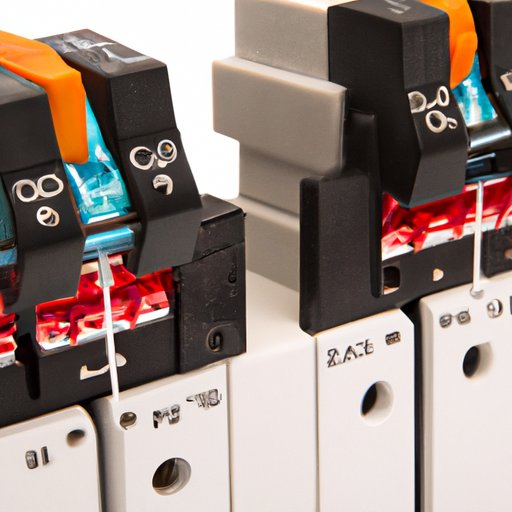Introduction
A circuit breaker is an important safety device in any electrical system. It works by monitoring the flow of electricity through the circuit, and when it senses too much current, it will trip and cut off the power supply. But what exactly causes a circuit breaker to trip? This article will explore the science behind circuit breakers, common causes of tripping, the hazards of overloaded circuits, and strategies for preventing and troubleshooting circuit problems.
Explaining the Science Behind Circuit Breakers: How Voltage and Amperage Affects Circuit Breaker Tripping
Before discussing the causes of circuit breaker tripping, it is important to understand the science behind these devices. When electricity flows through a circuit, it is measured in two ways: voltage and amperage. Voltage is the measure of electrical pressure, while amperage is the measure of the amount of electricity flowing through the circuit. The combination of voltage and amperage affects how much power is being used in the circuit, which in turn impacts whether or not a circuit breaker will trip.
Circuit breakers are designed to protect the circuit from too much current. If the amount of current exceeds the circuit’s rating, the circuit breaker will trip, cutting off the power supply. This prevents the circuit from becoming overloaded, which can cause fires or other damage.

Common Causes of Circuit Breaker Tripping: Identifying the Different Reasons for a Circuit Breaker to Trip
There are several different reasons why a circuit breaker may trip. The most common causes include short circuits, ground faults, and overloads. Let’s take a look at each one in more detail.
Short Circuits: A short circuit occurs when the hot (black) wire in the circuit comes into contact with the neutral (white) wire. This creates a direct path for electricity to flow, which can cause a sudden surge of current. If the current is too high, the circuit breaker will trip.
Ground Faults: A ground fault occurs when the hot wire comes into contact with the ground wire (green). This also creates a direct path for electricity to flow, but this time it is going through the ground instead of the neutral wire. Like with a short circuit, if the current is too high, the circuit breaker will trip.
Overloads: An overload occurs when too many devices are plugged into the same circuit. This can cause the total amount of current to exceed the circuit’s rating, which will cause the circuit breaker to trip.
Overloading Electrical Circuits: Understanding the Dangers of Exceeding Circuit Limits
When a circuit is overloaded, it is not only dangerous, but it can also cause serious damage to the wiring and appliances connected to the circuit. Overloaded circuits can cause wires to overheat, which can lead to fires. They can also cause appliances to malfunction, resulting in costly repairs.
It is important to be mindful of the number of appliances and devices that are plugged into a single circuit. Each circuit has a specific rating, and it is important to stay within this limit to ensure optimal safety.

Preventing Circuit Breaker Trips: Tips for Ensuring Optimal Electrical Safety
The best way to prevent circuit breaker trips is to be mindful of the amount of current flowing through the circuit. Make sure to check the rating of the circuit before plugging in multiple devices. Also, avoid plugging in high-wattage devices, such as space heaters and hair dryers, into the same circuit.
It is also important to be aware of any potential problems with the wiring. If you notice any frayed or exposed wires, have them repaired immediately. This will help reduce the risk of a circuit breaker trip due to a short circuit or ground fault.

Troubleshooting Circuit Breaker Problems: Strategies for Diagnosing and Resolving Circuit Issues
If you find that your circuit breaker is constantly tripping, it is important to identify the root cause of the problem. Start by making a checklist of all the potential causes, such as short circuits, ground faults, and overloads. Then, inspect the circuit and the wiring to determine if there is a problem. If everything looks okay, try unplugging some of the devices on the circuit to reduce the load. If the circuit breaker stops tripping, then you know that the issue was related to an overload.
If the issue persists, it is best to call a professional electrician. They can help diagnose the problem and provide a solution to resolve the issue.
Conclusion
This article explored the causes of circuit breaker trips, from short circuits to overloaded circuits. It is important to be mindful of the amount of current flowing through the circuit and to be aware of any potential problems with the wiring. Additionally, it is important to follow best practices for electrical safety, such as unplugging devices when they are not in use and avoiding plugging in high-wattage devices into the same circuit. Finally, if you are having trouble troubleshooting circuit breaker problems, it is best to call a professional electrician.
(Note: Is this article not meeting your expectations? Do you have knowledge or insights to share? Unlock new opportunities and expand your reach by joining our authors team. Click Registration to join us and share your expertise with our readers.)
